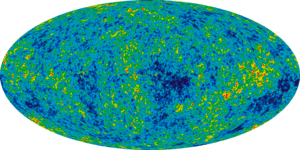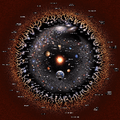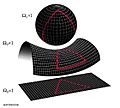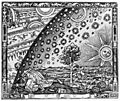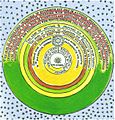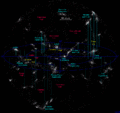Universe facts for kids
The Universe is all of time and space and its contents. It is made of many millions of millions of stars and planets and enormous clouds of gas separated by a big space.
Astronomers can use telescopes to look at very distant galaxies. This is how they see what the Universe looked like a long time ago. This is because the light from distant parts of the Universe takes a very long time to reach us. From these observations, it seems the physical laws and constants of the Universe have not changed.
Physicists are currently unsure if anything existed before the Big Bang. They are also unsure whether the size of the Universe is infinite.
Contents
History
People have long had ideas to explain the Universe. Most early models had the Earth at the centre of the Universe. Some ancient Greeks thought that the Universe has infinite space and has existed forever. They thought it had a set of celestial spheres which corresponded to the fixed stars, the Sun and various planets. The spheres circled about a round but unmoving Earth.
Over hundreds of years, better observations led to Copernicus's Sun-centred model. This was very controversial at the time, and was fought by religious authorities, most famously by the Christian church (see Giordano Bruno and Galileo).
The invention of the telescope in the Netherlands, 1608, was a very important moment in astronomy. By the middle of the 1800s, telescopes were good enough for other galaxies to be seen. The modern optical (uses visible light) telescope is still more advanced. Meanwhile, Isaac Newton improved the ideas of gravity and dynamics (equations) and showed how the Solar System worked.
In the 1900s, even better telescopes led astronomers to realize that the Solar System is in a galaxy made of billions of stars, which we call the Milky Way. They also realized that other galaxies exist outside it, as far as we can see. This started a new kind of astronomy called cosmology, in which astronomers study what these galaxies are made of and how they are spread out through so they can learn more about the history of the Universe and how it works. By measuring the redshift of galaxies, cosmologists soon discovered that the Universe is expanding (see: Hubble).
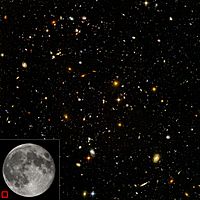
Big Bang
The most used scientific model of the Universe is known as the Big Bang theory, which says the Universe expanded from a single point that held all the matter and energy of the Universe. There are many kinds of scientific evidence that support the Big Bang idea. Astronomers think that the Big Bang happened about 13.73 billion years ago, making the Universe 13.73 billion years old. Since then, the universe has expanded to be at least 93 billion light years, or 8.80 ×1026 metres, in diameter. It is still expanding right now, and the expansion is getting faster.
However, astronomers are still not sure what is causing the universe to expand. Because of this, astronomers call the mysterious energy causing the expansion dark energy. By studying the expansion of the Universe, astronomers have also realized most of the matter in the Universe may be in a form which cannot be observed by any scientific equipment we have. This matter has been named dark matter. Just to be clear, dark matter and energy have not been observed directly (that is why they are called 'dark'). However, many astronomers think they must exist, because many astronomical observations would be hard to explain if they didn't.
Some parts of the universe are expanding even faster than the speed of light. This means the light will never be able to reach us here on Earth, so we will never be able to see these parts of the universe. We call the part of the universe we can see the observable universe.
Myths
The word Universe comes from the Old French word Univers, which comes from the Latin word universum. The Latin word was used by Cicero and later Latin authors in many of the same senses as the modern English word is used.
A different interpretation (way to interpret) of unvorsum is "everything rotated as one" or "everything rotated by one". This refers to an early Greek model of the Universe. In that model, all matter was in rotating spheres centered on the Earth; according to Aristotle, the rotation of the outermost sphere was responsible for the motion and change of everything within. It was natural for the Greeks to assume that the Earth was stationary and that the heavens rotated about the Earth, because careful astronomical and physical measurements (such as the Foucault pendulum) are required to prove otherwise.
The most common term for "Universe" among the ancient Greek philosophers from Pythagoras onwards was το παν (The All), defined as all matter (το ολον) and all space (το κενον).
Definition as reality
Usually the Universe is thought to be everything that exists, has existed, and will exist. This definition says that the Universe is made of two elements: space and time, together known as space-time or the vacuum; and matter and different forms of energy and momentum occupying space-time. The two kinds of elements behave according to physical laws, in which we describe how the elements interact.
A similar definition of the term universe is everything that exists at a single moment of time, such as the present or the beginning of time, as in the sentence "The Universe was of size 0".
In Aristotle's book The Physics, Aristotle divided το παν (everything) into three roughly analogous elements: matter (the stuff of which the Universe is made), form (the arrangement of that matter in space) and change (how matter is created, destroyed or altered in its properties, and similarly, how form is altered). Physical laws were the rules governing the properties of matter, form and their changes. Later philosophers such as Lucretius, Averroes, Avicenna and Baruch Spinoza altered or refined these divisions. For example, Averroes and Spinoza have active principles governing the Universe which act on passive elements.
Space-time definitions
It is possible to form space-times, each existing but not able to touch, move, or change (interact with each other. An easy way to think of this is a group of separate soap bubbles, in which people living on one soap bubble cannot interact with those on other soap bubbles. According to one common terminology, each "soap bubble" of space-time is denoted as a universe, whereas our particular space-time is denoted as the Universe, just as we call our moon the Moon. The entire collection of these separate space-times is denoted as the multiverse. In principle, the other unconnected universes may have different dimensionalities and topologies of space-time, different forms of matter and energy, and different physical laws and physical constants, although such possibilities are speculations.
Observable reality
According to a still-more-restrictive definition, the Universe is everything within our connected space-time that could have a chance to interact with us and vice versa.
According to the general idea of relativity, some regions of space may never interact with ours even in the lifetime of the Universe, due to the finite speed of light and the ongoing expansion of space. For example, radio messages sent from Earth may never reach some regions of space, even if the Universe would exist forever; space may expand faster than light can traverse it.
It is worth emphasizing that those distant regions of space are taken to exist and be part of reality as much as we are; yet we can never interact with them, even in principle. The spatial region within which we can affect and be affected is denoted as the observable universe.
Strictly speaking, the observable Universe depends on the location of the observer. By travelling, an observer can come into contact with a greater region of space-time than an observer who remains still, so that the observable Universe for the former is larger than for the latter. Nevertheless, even the most rapid traveler may not be able to interact with all of space. Typically, the 'observable Universe' means the Universe seen from our vantage point in the Milky Way Galaxy.
Basic data on the Universe
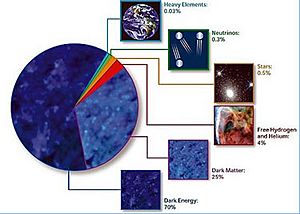
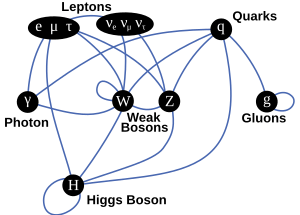
The Universe is huge and possibly infinite in volume. The matter which can be seen is spread over a space at least 93 billion light years across. For comparison, the diameter of a typical galaxy is only 30,000 light-years, and the typical distance between two neighboring galaxies is only 3 million light-years. As an example, our Milky Way Galaxy is roughly 100,000 light years in diameter, and our nearest sister galaxy, the Andromeda Galaxy, is located roughly 2.5 million light years away. The observable Universe contains more than 2 trillion (1012) galaxies and, overall, as many as an estimated 1×1024 stars (more stars than all the grains of sand on planet Earth).
Typical galaxies range from dwarf galaxies with as few as ten million (107) stars up to giants with one trillion (1012) stars, all orbiting the galaxy's center of mass. Thus, a very rough estimate from these numbers would suggest there are around one sextillion (1021) stars in the observable Universe; though a 2003 study by Australian National University astronomers resulted in a figure of 70 sextillion (7 x 1022).
The matter that can be seen is spread throughout the Universe when averaged over distances longer than 300 million light-years. However, on smaller length-scales, matter is observed to form 'clumps', many atoms are condensed into stars, most stars into galaxies, most galaxies into galaxy groups and clusters and, lastly, the largest-scale structures such as the Great Wall of galaxies.
The present overall density of the Universe is very low, roughly 9.9 × 10−30 grams per cubic centimetre. This mass-energy appears to consist of 73% dark energy, 23% cold dark matter and 4% ordinary matter. The density of atoms is about a single hydrogen atom for every four cubic meters of volume. The properties of dark energy and dark matter are not known. Dark matter slows the expansion of the Universe. Dark energy makes its expansion faster.
The Universe is old, and changing. The best good guess of the Universe's age is 13.798±0.037 billion years old, based on what was seen of the cosmic microwave background radiation. Independent estimates (based on measurements such as radioactive dating) agree, although they are less precise, ranging from 11–20 billion years. to 13–15 billion years.
The Universe has not been the same at all times in its history. This getting bigger accounts for how Earth-bound people can see the light from a galaxy 30 billion light-years away, even if that light has traveled for only 13 billion years; the very space between them has expanded. This expansion is consistent with the observation that the light from distant galaxies has been redshifted; the photons emitted have been stretched to longer wavelengths and lower frequency during their journey. The rate of this spatial expansion is accelerating, based on studies of Type Ia supernovae and other data.
The relative amounts of different chemical elements — especially the lightest atoms such as hydrogen, deuterium and helium — seem to be identical in all of the Universe and throughout all of the history of it that we know of. The Universe seems to have much more matter than antimatter. The Universe appears to have no net electric charge. Gravity is the dominant interaction at cosmological distances. The Universe also seems to have no net momentum or angular momentum. The absence of net charge and momentum is expected if the Universe is finite.
The Universe appears to have a smooth space-time continuum made of three spatial dimensions and one temporal (time) dimension. On the average, space is very nearly flat (close to zero curvature), meaning that Euclidean geometry is experimentally true with high accuracy throughout most of the Universe. However, the Universe may have more dimensions, and its spacetime may have a multiply connected global topology.
The Universe has the same physical laws and physical constants throughout. According to the prevailing Standard Model of physics, all matter is composed of three generations of leptons and quarks, both of which are fermions. These elementary particles interact via at most three fundamental interactions: the electroweak interaction which includes electromagnetism and the weak nuclear force; the strong nuclear force described by quantum chromodynamics; and gravity, which is best described at present by general relativity.
Special relativity holds in all the Universe in local space and time. Otherwise, general relativity holds. There is no explanation for the particular values that physical constants appear to have throughout our Universe, such as Planck's constant h or the gravitational constant G. Several conservation laws have been identified, such as the conservation of charge, conservation of momentum, conservation of angular momentum and conservation of energy.
Theoretical models
General theory of relativity
Accurate predictions of the Universe's past and future require an accurate theory of gravitation. The best theory available is Albert Einstein's general theory of relativity, which has passed all experimental tests so far. However, since rigorous experiments have not been carried out on cosmological length scales, general relativity could conceivably be inaccurate. Nevertheless, its predictions appear to be consistent with observations, so there is no reason to adopt another theory.
General relativity provides of a set of ten nonlinear partial differential equations for the spacetime metric (Einstein's field equations) that must be solved from the distribution of mass-energy and momentum throughout the Universe. Since these are unknown in exact detail, cosmological models have been based on the cosmological principle, which states that the Universe is homogeneous and isotropic. In effect, this principle asserts that the gravitational effects of the various galaxies making up the Universe are equivalent to those of a fine dust distributed uniformly throughout the Universe with the same average density. The assumption of a uniform dust makes it easy to solve Einstein's field equations and predict the past and future of the Universe on cosmological time scales.
Einstein's field equations include a cosmological constant (Lamda: Λ), that is related to an energy density of empty space. Depending on its sign, the cosmological constant can either slow (negative Λ) or accelerate (positive Λ) the expansion of the Universe. Although many scientists, including Einstein, had speculated that Λ was zero, recent astronomical observations of type Ia supernovae have detected a large amount of dark energy that is accelerating the Universe's expansion. Preliminary studies suggest that this dark energy is related to a positive Λ, although alternative theories cannot be ruled out as yet.
Big Bang model
The prevailing Big Bang model accounts for many of the experimental observations described above, such as the correlation of distance and redshift of galaxies, the universal ratio of hydrogen:helium atoms, and the ubiquitous, isotropic microwave radiation background. As noted above, the redshift arises from the metric expansion of space; as the space itself expands, the wavelength of a photon traveling through space likewise increases, decreasing its energy. The longer a photon has been traveling, the more expansion it has undergone; hence, older photons from more distant galaxies are the most red-shifted. Determining the correlation between distance and redshift is an important problem in experimental physical cosmology.
Other experimental observations can be explained by combining the overall expansion of space with nuclear physics and atomic physics. As the Universe expands, the energy density of the electromagnetic radiation decreases more quickly than does that of matter, since the energy of a photon decreases with its wavelength. Thus, although the energy density of the Universe is now dominated by matter, it was once dominated by radiation; poetically speaking, all was light. As the Universe expanded, its energy density decreased and it became cooler; as it did so, the elementary particles of matter could associate stably into ever larger combinations. Thus, in the early part of the matter-dominated era, stable protons and neutrons formed, which then associated into atomic nuclei. At this stage, the matter in the Universe was mainly a hot, dense plasma of negative electrons, neutral neutrinos and positive nuclei. Nuclear reactions among the nuclei led to the present abundances of the lighter nuclei, particularly hydrogen, deuterium, and helium. Eventually, the electrons and nuclei combined to form stable atoms, which are transparent to most wavelengths of radiation; at this point, the radiation decoupled from the matter, forming the ubiquitous, isotropic background of microwave radiation observed today.

Other observations are not clearly answered by known physics. According to the prevailing theory, a slight imbalance of matter over antimatter was present in the Universe's creation, or developed very shortly thereafter. Although the matter and antimatter mostly annihilated one another, producing photons, a small residue of matter survived, giving the present matter-dominated Universe.
Several lines of evidence also suggest that a rapid cosmic inflation of the Universe occurred very early in its history (roughly 10−35 seconds after its creation). Recent observations also suggest that the cosmological constant (Λ) is not zero, and that the net mass-energy content of the Universe is dominated by a dark energy and dark matter that have not been characterized scientifically. They differ in their gravitational effects. Dark matter gravitates as ordinary matter does, and thus slows the expansion of the Universe; by contrast, dark energy serves to accelerate the Universe's expansion.
Multiverse hypothesis
Some people think that there is more than one universe. They think that there is a set of universes called the multiverse. By definition, there is no way for anything in one universe to affect something in another. The multiverse is not yet a scientific idea because there is no way to test it. An idea that cannot be tested or is not based on logic is not science. So it is not known if the multiverse is a scientific idea.
Future
The future of the Universe is a mystery. However, there has a couple of theories based on the possible shapes of the Universe:
- If the Universe is a closed sphere, it will stop expanding. The Universe will do the opposite of that and become a singularity for another Big Bang. This is the Big Crunch or Big Bounce theory.
- If the Universe is an opened sphere, it will speed up the expansion. After 22,000,000,000 (22 billion) years, the Universe will rip apart with the force. This is the Big Rip theory.
- If the Universe is flat, it will expand forever. All stars will lose their energy for that and become a dwarf star. After a googol year, the black holes will also be gone. This is the Heat Death or Big Freeze theory.
- Edward Robert Harrison 2000. Cosmology 2nd ed. Cambridge University Press.
- -------- 2008. Cosmology. Oxford University Press. Challenging.
Related pages
- Is there a hole in the universe? at HowStuffWorks
Videos
Images for kids
-
Television signals broadcast from Earth will never reach the edges of this image.
-
Astronomers have discovered stars in the Milky Way galaxy that are almost 13.6 billion years old.
-
The formation of clusters and large-scale filaments in the cold dark matter model with dark energy. The frames show the evolution of structures in a 43 million parsecs (or 140 million light-years) box from redshift of 30 to the present epoch (upper left z=30 to lower right z=0).
-
3rd century BCE calculations by Aristarchus on the relative sizes of, from left to right, the Sun, Earth, and Moon, from a 10th-century AD Greek copy.
-
Model of the Copernican Universe by Thomas Digges in 1576, with the amendment that the stars are no longer confined to a sphere, but spread uniformly throughout the space surrounding the planets.
-
A map of the superclusters and voids nearest to Earth
See also
 In Spanish: Universo para niños
In Spanish: Universo para niños


